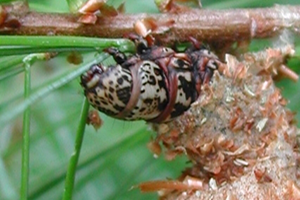Thyridopteryx ephemeraeformis
Photo Credit: Pennsylvania Department of Conservation and Natural Resources - Forestry , Bugwood.org. Creative Commons Attribution 3.0 United States (CC BY 3.0 US) License; https://creativecommons.org/licenses/by/3.0/us/.
Thyridopteryx ephemeraeformis
Common Name: evergreen bagworm moth
Animal Guild: Insect
Class > Order > Family: Insecta > Lepidoptera > Psychidae
Where is the species found?
States & Provinces
AL, AR, CT, DE, FL, GA, IA, IL, IN, KS, KY, LA, MA, MD, MO, MS, NC, NE, NJ, NM, NY, OH, OK, PA, RI, SC, TN, TX, VA, WI, WV
Which phenophases should I observe?
Do you see/hear...?
Activity
Adults Thyridopteryx ephemeraeformis , females are yellowish, maggot-like, cannot fly, and do not leave their bag (pupal case), so they are rarely seen. Males are black and hairy with clear wings.More...
For abundance, enter the number of individual animals observed in this phenophase.
Reproduction
Mating Thyridopteryx ephemeraeformis , females are flightless and mating occurs while they are still in their bag (pupal case).
For abundance, enter the number of individual animals observed in this phenophase.
Development
Caterpillars Thyridopteryx ephemeraeformis , the black and brown caterpillars construct a tiny "bag" around themselves from silk and plant debris, enlarge it over time, and carry it with them as they move.
For abundance, enter the number of individual animals observed in this phenophase.
Caterpillars feeding Thyridopteryx ephemeraeformis , caterpillars feed on the leaves and needles of deciduous and evergreen trees and shrubs.
For abundance, enter the number of individual animals observed in this phenophase.
Dead adults For abundance, enter the number of individual animals observed in this phenophase.
Dead caterpillars For abundance, enter the number of individual animals observed in this phenophase.
Method
Individuals at a light For abundance, enter the number of individual animals observed in this phenophase.
Individuals in a net For abundance, enter the number of individual animals observed in this phenophase.
Individuals in a trap For abundance, enter the number of individual animals observed in this phenophase.
What do these phenophases look like?
The following Phenophase Photo Guides for this species have been vetted for accuracy by the USA-NPN National Coordinating Office. Most photo guides are developed for a particular local or regional monitoring effort, and some of the content may not apply to your effort or your region. However, we make them available to provide as much help as they may in illustrating phenophases for this species. If you have high quality phenophase photos that you are willing to share with us, please visit the Phenophase Photo Guidelines page.
Be aware there is variation from individual to individual within a species, especially across different regions, so your plant may not look exactly like the one pictured.
Since they do not always include complete definitions for the species, use these photo guides ONLY in conjunction with the official Nature's Notebook phenophase defintions included in the table above, in the phenophase definition sheet that downloads with the datasheet, or in the Observe screen in the mobile app.
